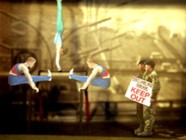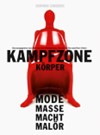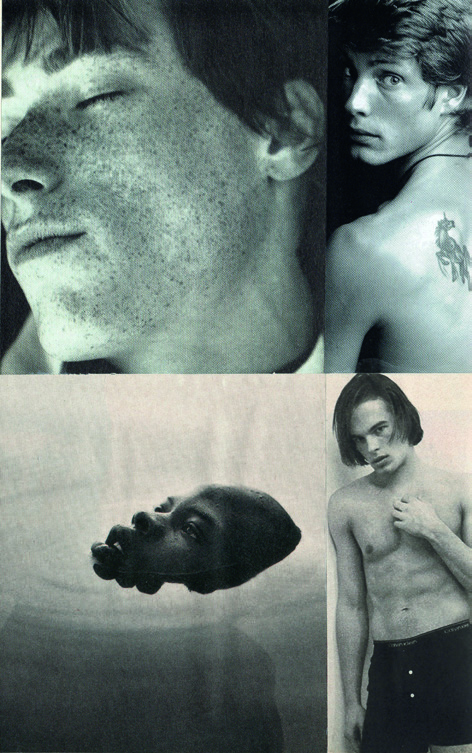Gerrit Jan Vos (1962–2017)
Gerrit Jan Vos (27 August 1962 (Enschede ) – 10 March 2017 (Amsterdam)) had a particular passion for men’s fashion, photography, collecting images of men and creating collages.
His great interest in men’s fashion was reflected in his work at the Willem de Kooning Academy in Rotterdam, where he worked as senior lecturer in fashion; before that he lectured in the Design department at Fachhochschule Bielefeld (now FH Bielefeld University of Applied Sciences) in Germany.
Gerrit Jan was an active photographer, both on commission and in his own free time. Walking round with his camera, he regularly photographed people and works of art, often in the public space.
His desire to collect expressed itself through collecting photos and images of men, some in uniform, some not. Gerrit Jan used many images, again of men, in collages in his scrapbooks.
Life
Gerrit Jan Vos was born in the Dutch city of Enschede on 27 August 1962, the youngest in a family of four children. He was described as an introvert and a loner by nature.
Together with his brother and two sisters, he grew up in an Orthodox Protestant milieu. His mother was a housewife, his father a painter and decorator. His parents originally came from Groningen in the north of the country, but settled in Enschede when Gerrit Jan’s father found work there with his brother’s firm.
About Vos (as per 7 October 2016 on his English-language website Vos-Co.nl (since taken down))
Organising fashion shows, fashion illustration/photography, exhibitions, workshops, lectures.
He provides services internationally in fashion and design, visual communication and conceptual thinking, with a particular focus on men’s clothing.
Projects
Samsung, Sanoma Publishers, Union Knopf, Herren Mode Woche, Gabor Shoes, WDR, Kaiga, Maconde, Uco, Nigel French, IN.DEX, Fabrex Fair, LOI, Rijksmuseum, Philips, Swan & Nichols, View Textile, Interior View, Metropolitan Publishing, David Shah, Li Edelkoort, Trend Union, Premiere Vision, Mode Amont.
Lecturer
Head of Fashion at Willem de Kooning Academy, Rotterdam.
FH University of Applied Sciences: Design Department, Bielefeld. Germany.
AKI Academy of Art & Design, Enschede. Netherlands.
Central Saint Martins College of Art and Design, London, Great Britain.
Gerrit Jan was a dreamer, enjoyed being in nature and loved plants. After leaving primary school, he went to the junior secondary horticultural school (Lagere Tuinbouw School) in Enschede. He obtained his certificate in 1977 and went on to the senior secondary horticultural school (Middelbare Tuinbouw School) in Nijmegen. Gerrit Jan was then just 15 years old, and moved in to lodgings with a hostess. After completing his secondary education, Gerrit Jan returned to Enschede, where in 1982 he attended evening classes at the AKI Academy of Art & Design. A year later, he switched to a full-time programme.
On moving back to Enschede, Gerrit Jan went to live in lodgings, broke with the church and came out as openly gay. When visiting his parents, homosexuality was never mentioned.
From his second year at the AKI Academy, Gerrit Jan began specialising in fashion and photography. He had his own drawing style, but was less interested in the actual design and making of a collection. He was mainly occupied with styling and photography. Gerrit Jan graduated from the AKI Academy in 1988 in Fashion and Photography, after which he moved to Amsterdam.
It was in Amsterdam that Gerrit Jan found his first employment. Among the people he came into contact with was the stylist and photographer Ruud van der Peijl, who was just a little older than Gerrit Jan. In the early 1990s he spent 18 months working as a freelance stylist with Li Edelkoort in Paris. He lived with a boyfriend during this period.
From 1992 onwards, Gerrit Jan delivered a number of guest lectures in the Fashion department at the AKI Academy. In that same year, he also gave guest lectures at Central Saint Martins College of Art and Design in London. Two years later, Gerrit Jan lectured on one or two days per week in collection design in the Design department of Fachhochschule Bielefeld (FH Bielefeld) University of Applied Sciences in Germany. This appointment was facilitated partly by Professor Eric van den Kleijenberg, who was already teaching there.
Eric van den Kleijenberg lived in Arnhem and had a small apartment in Bielefeld. For many years, Gerrit Jan travelled every Sunday from Amsterdam to Arnhem, from where he and Eric drove to Bielefeld. On Wednesdays they would drive back to the Netherlands together. The appointment in Bielefeld came to an end in 2005.
The salary from his job in Bielefeld was not enough to live on, and during this period Gerrit Jan carried out freelance commissions as well as working all kinds of side jobs in order to make ends meet. Among other things he worked in the hospitality industry and in a gallery. Although he had little income during this period, Gerrit Jan was determined to do the things he enjoyed doing.
In 1996 he got to know Bart Verlaan. They developed a relationship, and remained a couple until Gerrit Jan’s death in 2017.
In 2007 Gerrit Jan began working as a lecturer in the Art department of the Willem de Kooning Academy in Rotterdam. As head of the Fashion department he was in his element. He put his heart and soul into his work for his students and for the Academy. He was a strong advocate within the Academy for more attention to be given to men’s clothing.
In 2015 Gerrit Jan was given an opportunity to study for a Master’s degree in Fashion Matters at the Sandberg Instituut (the Sandberg Instituut is the postgraduate programme of the Gerrit Rietveld Academie Amsterdam). Studying for this degree enabled Gerrit Jan to focus anew on his discipline. Sadly, he was not able to complete the programme, something which he greatly regretted when, during the short period in his sickbed, he was forced to accept that he would not get better. Gerrit Jan died on 10 March 2017 at his home in Amsterdam.


A selection of art projects
Vos-Co website
Gerrit Jan set up his own website in 2004, under the name Vos-Co. The homepage of the English-language site (no longer online) contained the following information, spread over a number of underlying pages:
I take photos while walking round with my camera.
Scrapbook
contains pictures of graffiti, objects and people, as well as a few works of art.
(23 photos)
Streetview
is dedicated to images of pedestrians. (30 photos)
Stray Dogs
is a combination of pictures of dogs and their owners. (12 photos)
Locked
these are leather sculptures I made in Chateau de Vaulx, Saint-Julien de Civry, France. (9 photos)
Book
in collaboration with Professor Eric van den Kleijenberg and Professor Uwe Göbel, we created the book Kampfzone Körper (‘Body Cult’). It is about fashion, photography, young fashion designers and photographers.

After Gerrit Jan’s death, the website was taken off-line. The pages do however show that he remained active as a photographer. He photographed people and artworks in the public space.
Duo exhibition Boys & Soldiers in Villa Lila, Nijmegen (2004)
In the period 2004 – 2007 Gerrit Jan made between 15 and 30 ‘viewing boxes’: three-dimensional collages, each smaller than a shoebox. A selection was exhibited in 2004 in a duo exhibition entitled Boys & Soldiers at Villa Lila (homebase of the Nijmegen LGBTI movement).
They comprise scenes made up of photos based on the theme of the soldier/military. The scenes depict soldiers in a variety of situations, either as part of a group or as solitary figures in interaction with other individuals.
The idea behind this work is that the concept of soldier/military evokes differing reactions and emotions. Soldiers are not only canon-fodder, but can also be peacekeepers.


Villa Lila, Nijmegen, from
2 May to 20 June 2004
Book: Kampfzone Körper – Mode Masse Macht Malör (2008)
This book, edited by Eric van den Kleijenberg, Gerrit Jan Vos and Uwe Göbel, was published by the Design department at FH Bielefeld University of Applied Sciences in 2008 to accompany the symposium Körper als Kampfzone. Fotografie und Mode im Dialog. 29. Symposium des Forschungsschwerpunktes Fotografie und Medien. 21. und 22. (‘Body Cult. Photography and Fashion in Dialogue. 29. Research Symposium on Photography and Media. 21 and 22.’), November 2008. Gerrit Jan himself described the book as: ‘A publication and trend briefing on visual weaponisation in our daily lives.’
Gerrit Jan wrote the Introduction to the book together with Eric van den Kleijenberg and Uwe Göbel.
He was also responsible for two photo reportages containing male models, respectively entitled Héros, in collaboration with the photographer Cedric Pradel, and Hope is a Walking Dream, in which the models were photographed by Marco van Rijt.


Mode
Masse
Macht
Malör
Exhibition concept PLAKARTIVE, Bielefeld (2012)
In the summer of 2012, Gerrit Jan took part in a new exhibition concept for the town of Bielefeld entitled PLAKARTIVE. It was an initiative of his former colleague Uwe Göbel from FH Bielefeld University of Applied Sciences. It was an open-air exhibition in the town, intended as a biennale, which made use of existing and newly added billboards.
Gerrit Jan’s contribution can be seen on one of the 45 billboards. It depicts a life-size image of a beige-coloured cloth doll, with red accents on its head, hands and feet. The doll’s face is hidden behind a mask. The doll is sitting on a square block and is holding a board bearing the widely spaced text ‘Whatever Happened To all the Porn Stars ?’. There are two small rectangles at the top of the image; the one on the left looks like a torn mailing label, while the one on the right contains the framed text SZENE-INFO, written in irregular yellow letters on a red ground.

from 22 June to 31 August 2012
[Image taken from Vos-Co website; screenshot on 7 October 2016]
Talk: Dress to Impress, over de relatie tussen kleding en macht (‘Dress to Impress. The relationship between clothing and power’) In Debatpodium Arminius, Rotterdam (2014)
On 13 September 2014, Gerrit Jan gave a talk as part of the Nacht van de Dictatuur (Night of the Dictatorship) event, entitled ‘Dress to Impress, over de relatie tussen kleding en macht’ (‘Dress to Impress. The relationship between clothing and power’). The talk focused on how clothing can convey a sense of dominance and power. What are the most impressive uniforms and why? And does this vary according to particular cultures or countries? Gerrit Jan recorded little on paper in his working life and generally delivered his lectures and presentations from memory, which means that no written trace of this lecture remains.
Collecting photos and making collages
Gerrit Jan was an intuitive collector. A photograph had to appeal to him, and this was mainly the case with photos of men. Given the discipline in which he worked and his interest in men’s fashion, these are often photos of men in uniform. Occasionally, Gerrit Jan bought a family photo album, but this was more for commercial dealing than to add to his own collection. After his death, his collection of more than 4,000 photographs was gifted to IHLIA LGBTI Heritage.
Over the years, Gerrit Jan also filled around 20 scrapbooks with collages (22 cm high by 15 cm wide). He filled the pages of these hardcover dummy books with photos he had clipped out from newspapers and magazines, though pornographic magazines found along the roadside were also a source of inspiration. The collages consist mainly of images of men. In putting together a collage, Gerrit Jan was mainly interested in the composition and theme of the photos. The scrapbooks filled with Gerrit Jan’s collages are in the possession of Bart Verlaan.










Information
- Interviews with Bart Verlaan on 1 December 2022, 21 and 24 January 2023
- Wayback Machine – Internet Archive. Website ‘Vos-Co.nl’. Screenshots on 7 October 2016: https://archive.org/web/ vos-co.nl
- Wayback Machine – Internet Archive. Exhibition ‘Boys & Soldiers’ website villalila.nl page Webgallery 2004. Screenshots from 3 April 2005 https://archive.org/web/ villalila.nl
- RKDartists&. Gerrit Jan Vos: https://rkd.nl/nl/explore/artists/81895
- Book ‘Kampfzone Körper – Mode Masse Macht Malör’:
- https://ihlia.nl/search/?q%3Asearch=Kampfzone+K%C3%B6rper+-+Mode+Masse+Macht+Mal%C3%B6r&lang=nl
- Ausstellungskonzept PLAKARTIVE:
- https://nachrichten.idw-online.de/2012/06/11/kunst-unterm-ostwestfalendamm-auf-45-plakatflaechen-in-bielefeld
- Lecture ‘Nacht van de Dictatuur’: https://arminius.nl/nacht-van-de-dictatuur/
- Gerrit Rietveld Academie, Annual Report 2017. Page 23
- Internship report ‘IHLIA LGBT Heritage Research Project, Gerrit Jan Vos Collection’ by Jordan Browne
